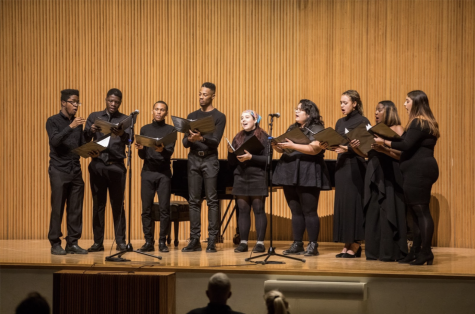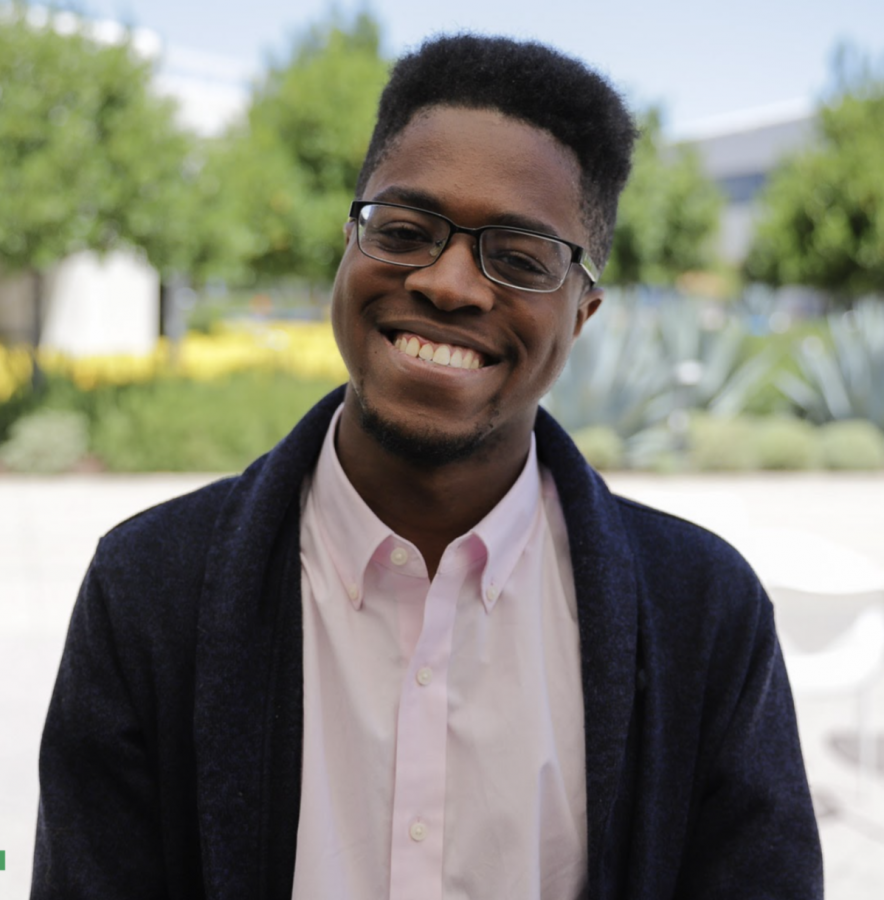Courtesy of Max Addae
Double degree fifth-year Max Addae: Musician, Composer, Vocalist/Vocal Arranger, and Creative Technologist
What inspires you to create?
Before getting any experience in composition and computer programming, I had a heavy performance background in vocal and instrumental music, so naturally live performance and storytelling are such core aspects of my artistic practice. As I started learning more about programming, I found myself continually applying these skills to creative and musical contexts, and being so inspired by the power of technology to enhance human expressivity in unimaginable ways. I believe technology has limitless power in providing musicians with new ways to create and interact with music. It allows performers to communicate emotions, stories, and ideas that cannot be conveyed through any other medium. As such, my interest in technology-enhanced storytelling and performance is one of the most driving forces for me in the work I create.
What is the function of your art?
Especially recently, I’ve been thinking a lot about the positionality of my art as a Black creative technologist and electroacoustic artist. As much as people may like to believe technology is neutral, there are so many ways in which technology causes harm to my communities and promotes white supremacy (e.g., facial recognition software, surveillance, social media), and sometimes it can feel like being a Black technologist is almost a betrayal of my Blackness. At the same time, though, I find it really empowering to think about incorporating Black aesthetics into technology, and to visualize technology as this futuristic tool for presenting innovative Black narratives and empowering Black bodies (as explored in Afrofuturism and African-American science fiction, especially). I plan to explore these topics in my Senior TIMARA Recital this semester, which will be a video performance project that reimagines Black Americans’ relationship to technology through music, sound, poetry, and dance.

What role does artmaking play in your life?
On one level, artmaking is a huge source of healing for me. Especially during the early months of quarantine when we were first sent home, my music was quite literally all I really had to process the multitude of feelings I was experiencing, and I can’t even imagine where I’d be at, mentally, without it. On another level, artmaking is also such an important avenue for me to collaborate and connect with my larger artistic communities. The artistic and creative community at Oberlin is one of the main things that has kept me sane during my time here, and some of my most valuable artmaking experiences have been through collaborative art-making projects: namely, working with The Obertones, The Oberlin Black Musicians Guild (OCBMG), and my band, The Blackberry Poets (TBP), with [College third-year] Cyril Amanfo and [Double degree fourth-year] Mark Ligonde. For me, the bonds I have established with people while working together on music and art are completely unmatched, and those bonds are one of the most essential sources of inspiration and motivation for me artistically.
Would you say your artmaking is a healing experience?
Absolutely! In the past year, especially, artmaking — especially collaborative art-making — has been such an essential part of my mental stability. If this pandemic has taught me anything, it is that artistic collaboration is boundless. Even while being physically separated all across the country, I’m so fortunate to have been able to find ways to continue singing with the Obertones remotely, and to produce original music over Zoom with Cyril and Mark as if we were in the same room together. Of course, nothing can beat the joy of live performance and collaboration for me. Yet, in times like these where you can fall into isolation and loneliness really easily, it’s so magical to be able to achieve that healing through artistic collaboration, even from a distance.
Where do you want to see your art?
I’d want to see my art wherever it can make an impact on people: whether that be in a recital hall, on streaming platforms, on a Broadway stage, in a family’s living room — wherever! I’m not sure I’d say I aspire to be “famous,” necessarily, but I’m certainly open to any and every way my music can provide joy and healing to others.
How do you begin your creative process?
As you can expect, the creative process can look vastly different depending on the project or piece in question, but in general it often begins with a small core idea (often a poem, a motif, a harmonic progression, a theme), and I try to gradually build and expand on it. Sometimes, when I’m in a creative rut or if I’m feeling a little drained, I try to take a step back and just consume art that I enjoy. Not necessarily for the sake of “finding inspiration,” per se, but more so as a way of grounding and re-centering myself — sort of like a “creative reset button.” Maybe I’ll listen to an album I haven’t heard all the way through before, or I’ll watch performance videos of artists I admire, or sometimes I’ll even watch old performance videos of my own (either as a solo artist or within larger group performances), just to remind myself of the things that truly move me and the reasons why I create and perform music. I’ve found that hitting that “reset” button every so often really helps me jumpstart my creative mindset, and puts me in a better position to develop meaningful work.
Who are your influences and inspirations?
Oooh, this might be a long one, buckle up! I get inspiration from so many different sources. The creative technologist part of me is heavily inspired by artists like George Lewis, Imogen Heap, and Pamela Z who create such deeply intimate and interactive relationships between themselves as performers and their technology. When it comes to my vocal arranging, I get a ton of inspiration from choral composers like Eric Whitacre and Frank Ticheli, as well as some contemporary a cappella groups like Pentatonix, the Nor’easters, and so many others. And then of course, the Oberlin artistic scene has a monumental impact on my creativity. I feel like practically every weekend before COVID times, I would walk out of a friend’s recital, or a theater performance, or a dance showcase feeling so inspired and driven to work on my music. I’m so fortunate to have connected with so many talented and passionate artists at Oberlin, and I think my artistic growth and inspiration is very much a direct result of the creative scene the Oberlin community cultivates.
To what degree does your art reflect the world around you?
For me, at least, I feel like art is inherently a response to the world around me and my lived experiences within it. Of course, this can be more or less “blatant” or conscious, depending on the piece in question, but I personally believe music and art, by nature, exists within larger contexts (personally, historically, culturally, socially, etc.), and recently I’ve been trying to become more comfortable discussing my personal experiences as a Black queer man in my work. It can be incredibly daunting to put so much of your heart on your sleeve as an artist, but I think the power we hold as artists to provide healing both to ourselves and others around us through our work can make the increased vulnerability so worth it.
